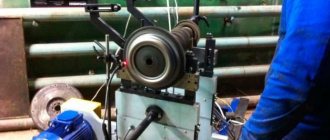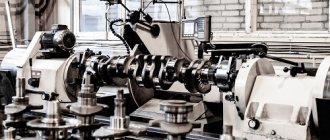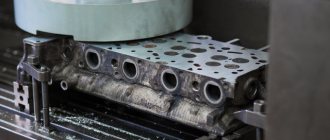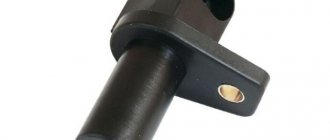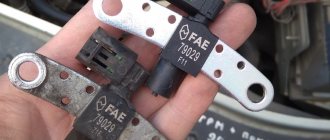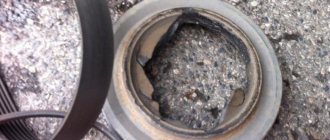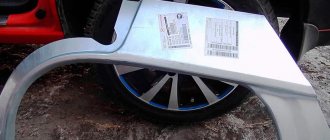02/04/2022 8,863 Engine
Author: Ivan Baranov
Over time, any component or unit of the vehicle will need repair. Many motorists are faced with the issue of crankshaft grinding as a result of wear on the working surfaces of various bearings. This material is dedicated to the technological process of restoring crankshafts.
[Hide]
Polishing the crankshaft is an important and responsible process
The crankshaft is an important part of a car engine, which, in fact, sets it in motion.
During operation, it is subjected to significant loads, and if damaged, replacing it will cost the car owner a pretty penny. As a rule, polishing a crankshaft is much cheaper than replacing it. Naturally, boring a crankshaft is a very responsible process, requiring special equipment and skill of the performer. After all, the slightest inaccuracy can lead to its damage, which is extremely undesirable, since additional engine repairs will be required.
There are several reasons why the crankshaft wears out, here are just a few of them:
- Insufficient lubrication, which can lead to scuffing of the crankshaft journals.
- Using low-quality oil or the wrong brand of oil recommended by the car manufacturer.
- Untimely replacement of oil filters.
- Running the engine at maximum speed while it is not yet sufficiently warmed up.
Before you start polishing or grinding crankshafts, you must thoroughly clean and rinse the oil channels and check the condition of all components, in particular the main and connecting rod bearings. But in any case they will have to be changed. The main defects of the crankshaft can be its deformation, that is, curvature, as a result of which it begins to “beat”, or scuffing of the journals. These defects provoke rapid wear of the working surface and also increase the clearances in the bearings. Before polishing the crankshaft, you need to carefully check its position using an indicator stand and balance it using weights.
The boring process usually starts with the crankpins, since they are the weak point. After polishing, the internal stresses on the connecting rod journals may change quite significantly, which will entail deformation of the entire crankshaft. If work starts from the fundamentals, this can lead to beating, which will again lead to deformation.
It is recommended to start polishing from the main journals only of “non-rigid” shafts, since they are quite subject to deformation, and their connecting rod journals are smaller in diameter and do not have counterweights. Also, during the work process, it is necessary to take into account the radius of the fillets, since as a result of cutting them, a decrease in strength and breakage of the crankshaft may occur. To more accurately determine the repair size, you need to start polishing from those necks whose wear is maximum. Upon completion of work, it is necessary to check the geometry. If the crankshaft is grinded at a professional level, then 0.3 millimeters of ellipse, minimal taper and runout can be achieved.
But that’s not all, since there are micro-scratches on the surface of the crankshaft that will damage the liners. Therefore, the final operation is polishing the crankshaft. During polishing, the crankshaft is first treated with fine sandpaper and then with an abrasive mixture, so that all micro-burrs and burrs are completely eliminated.
You can find out detailed information about prices, as well as sign up for crankshaft polishing by calling:
Detonation spraying
The most promising way to restore crankshaft parameters is detonation spraying. In this process, the acceleration of the powder flow from the storage hopper to the surface occurs due to the energy of the explosion produced inside the gas flow.
A detonation gun is used. It has a water-cooled barrel at one end. It is filled with a gas mixture, which can explode when the desired concentration is reached.
As a result of the explosion, a jet appears in a limited space, the speed of which is 1000...1200 m/s. When colliding with a hard surface as a result of an impact in the contact zone, the temperature rises to 2000...2200 ⁰С. The contact zone is instantly heated and the particle forms a rigid bond with the body. It is extremely difficult to destroy mechanically. Microwelding connects dissimilar powder and steel surface.
Detonation spraying of solid powders:
After the “shot,” the barrel is purged with non-flammable gas. The flow not only hits the barrel, it is directed to the welding zone, cooling it to 20...30 ⁰С. Then the process resumes. Another shot occurs. Another certain amount of powder is fed to surfacing.
This method of surfacing (spraying) surpasses any other option in its parameters.
Attention! Detonation spraying can be carried out not only on metals. Powder flow welds onto plastics, ceramics, glass and other refractory materials
Currently, individual high-tech equipment can be designed and manufactured by order of interested enterprises. Of course, the price for it can be quite high. The high quality of restored parts will allow you to recoup your investment.
Video: crankshaft restoration.
Polishing the crankshaft yourself
Has anyone held a crankshaft from a mid-size car engine in their hands? We’re not talking about small funny minicars with motors from a garden trimmer, but we’re talking about the middle class of cars, for example, like Solaris or Mazda-6? And how much do you think such a piece of iron weighs?
So here's what. Almost every engine that undergoes cosmetic repairs and is disassembled down to the screw requires restoration of the working surfaces of the crankshaft journals - I have yet to meet practically any engine that has an average mileage of more than one hundred thousand km and does not have marks or scuffs on the working surface of the crankshaft journals shaft And for this reason, even if the surface of the journals does not need to be ground to the next repair size, then it is absolutely necessary to grind it “clean”. And for this, the crankshaft must be taken to a specialized workshop, where it will be installed in a special machine and the surfaces of the journals, thrust half-rings and the oil seal work area will be polished. Equipment for boring and grinding shafts is quite bulky and expensive, so it is impractical to have it in every service center, but also to constantly carry it to specialists. the workshop is reluctant to use heavy shafts.
For such purposes (restorative grinding of the surfaces of journals and working areas of crankshafts), mobile (manual) equipment was invented and manufactured, which has found application in other industries where it is necessary to process (grind) convex or cylindrical surfaces of parts made of various materials - both metal and and plastic, ceramics, stone.
In our case (car service), the need to have such a device was dictated by a clearly defined task - constantly carrying crankshafts from engines under repair to other workshops (to a mechanical plant) is inconvenient (I remind you that these pieces of iron weigh a lot, and therefore heavier, the larger the engine. And if the engine of even a light truck is being repaired, then the pleasure here is below average); and another reason is the loss of time for processing, and there is also reluctance to give money for something that you can do yourself. Well, so... a tool that was essentially universal and optimal for use was made - a saber-type manual belt sander. Almost from available materials, a metal structure was welded, resembling a bow, on which two rollers with a “groove” were attached to the working surface (with sides), one of which sat on a rigid axis welded to the “bow”, and the second was movable, with the help of which You can tighten the installed sanding belt. The belt is driven by a third roller mounted on the shaft of an angle grinder (angle grinder), which also has side limiting edges. The electric motor of the machine has a continuously adjustable rotation speed knob, which allows you to change the speed of the belt.
So, we assembled the structure, installed and tensioned the abrasive tape. The new tape requires preliminary “running-in” on any unnecessary part to eliminate the possibility of damage to critical surfaces of the crankshaft by scratches. The crankshaft itself is mounted on supports - prisms (having a V-shaped cutout on top) on oil-soaked rag gaskets. To uniformly treat the surface of the journals, it is necessary to rotate the crankshaft at a low speed and evenly, excluding the operation of the belt at one point. For rotation, you can use an electric motor with a gear drive that reduces the speed or, as we actually did, a powerful gear screwdriver at the lowest possible speed. An assistant uses a screwdriver to smoothly rotate the crankshaft lying in the prisms, while with a grinder, with light pressure on the part, at medium speeds of the belt movement, each journal, in turn, and the working area of the shaft seal are ground. Grinding the journals takes a total of about 6-7 minutes, the surface of the journals is homogeneous and has the roughness necessary for work (to retain the oil film), after processing the crankshaft is washed, the internal lubrication channels are cleaned and blown out - the remaining residue from the belt gets into the working friction zone of the liners can cause a lot of trouble. When carrying out engine repairs, this operation, performed on site, saves both money and time - you had to wait several days for the parts to be returned after processing from a specialized enterprise! And now everything is fast, beautiful and without leaving the checkout. )))
Description of the grinding device
Shaft grinding is carried out using a grinding wheel. This circle is a porous body consisting of a large number of abrasive grains. These grains are held together by a binder. In addition, pores are located between these grains and ligaments. The grains themselves are made of very durable material, and their number reaches tens or even hundreds of thousands.
As for the working profile of the wheel for grinding shafts, it consists of cutting edges of abrasive grains. They are located at different distances from the surface. In addition, the grinding process is a procedure during which chips are removed. Due to the fact that large quantities of chips are removed, this leads not only to grinding of the material, but also to a significant release of heat in the contact zone. It is for this reason that this operation is carried out only if there is a constant supply of large quantities of lubricants and cooling substances.
Grinding the crankshaft journal
Grinding the crankshaft journals is one of the most labor-intensive repair procedures. Its implementation in a home workshop is almost impossible, as it requires the use of high-precision tools. Also, repairmen will need certain work experience. You most likely won’t be able to trust private craftsmen - equipment for grinding the shaft journal can only be found in large workshops. Let's try to figure out why to grind this unit, how to prevent its premature failure and where is the best place to carry out repair work.
detailed instructions
We have dealt with the causes and symptoms of the need for recovery. Where to bore the crankshaft and how much does it cost? This is exactly the question that comes to the mind of every vehicle owner who is faced with the need to repair a unit. The answer is simple - the crank pulley can be bored at home, of course, if you have the necessary equipment (machine), tools and certain knowledge.
But you must understand this topic as much as possible, since studying technical literature and looking once, as a specialist does, will be extremely insufficient. At a minimum, you need to have relevant experience. So, how boring occurs - the entire technological process with a detailed description is provided below.
Why is the shaft journal grinded?
The crankshaft (also known as the crankshaft) is a critical part of an internal combustion engine, responsible for transmitting the reciprocating movements of the pistons into rotation. The part has a rather complex shape, machined to within hundredths of a millimeter. The piston connecting rods are fixed to the crankshaft journals - these are cylindrical supports responsible for transmitting force from the pistons. Attachment is performed using plain bearings.
It should be noted that such an important part is made of high-strength steel, which is slightly subject to wear. However, wear does occur, and its intensity depends on many factors, including how you drive the car. The main and connecting rod bearings used here are in contact with the shaft through replaceable bearings. In case of repair, they must be replaced.
What happens during the operation of an internal combustion engine? The liners gradually wear out (even with the most careful and gentle driving), and at the same time the journals on which the piston connecting rods are attached also wear out. At some point, wear becomes so great that further operation of the engine becomes impossible - it needs repair. At the same time, there is no need to completely change the expensive shaft yet - it can be repaired:
- The engine is disassembled and the shaft is removed from it;
- The crankshaft journals are polished;
- Inserts worn out during operation are replaced.
After this, the engine is assembled and tested.
The apparent simplicity of repair work hides its complexity. Any mechanic can disassemble the engine and remove the crankshaft. The same applies to removing connecting rods. But grinding the crankshaft journal is only possible if you have a lathe capable of removing hundredths of a millimeter of metal. You won’t be able to get by with a simple industrial lathe or homemade equipment – high precision is required here. That is why grinding of the crankshaft journals is carried out only in workshops where the appropriate equipment is available.
What should you consider when grinding the shaft journal? It is necessary to find the neck with maximum wear and build on it, taking into account the repair dimensions of the liners. After this, the shaft is fixed in a lathe and turned to the selected size - tenths or even hundredths of a millimeter of metal are removed, depending on the degree of wear. The lathe turns the journals so precisely that the finished surface is perfectly flat. Next, the shaft is washed, installed in place, and the engine is assembled. The next stage is a gentle running-in for several days, which will show how the internal combustion engine behaves. If all is well, you can begin daily use as usual.
Crankshaft loose
The crankshaft driller may make a mistake and loosen the crankshaft, then the engine will not have good oil pressure, and also because of this the engine may knock quickly.
Photo. This way you can turn the crankshaft on a VAZ engine with a key.
You can check for weakness in the crankshaft like this. Tighten the cushion and spin the crankshaft; if it spins very easily, it doesn’t hurt to check whether the crankshaft is loose or not.
Usually, after a good boring, the crankshaft does not clamp and turns easily. Remove the cushion, take out the liner and place chocolate foil under the liner, tighten the liner, if the crankshaft gets tight or starts to turn noticeably more difficult, it means that this crankshaft journal is bored perfectly, pull out the foil from under the liner and check the next pillow.
Photo. It is shown how to place foil under the liner, and be sure to cut off the excess foil with the tip of a knife; it is shown here that the foil is cut off on one side and not on the other.
If, after placing foil under the liner, the crankshaft does not turn more difficult, it means that this crankshaft journal is weakened, place more foil under this cushion between the liner until the crankshaft begins to turn more difficult. After all the pillows have been checked and found to be loose, and if more than one foil had to be placed under the liner, then you will have to completely remove the crankshaft and under those journals that had to be placed more than one foil, you will need to divide the foil strips into two and place half of the foil under the liner in the block. Install the crankshaft, tighten it, that's it, you have perfectly adjusted the liners, and the crankshaft will work perfectly in the engine.
Be sure to put a nail in the foil under the liner and make a hole through the holes in the liner for the oil to pass through.
How to prevent crankshaft damage
The key influence on the crankshaft is the driving character. Sharp jerks, racing on the highway, driving at high speeds - all this leads to increased wear. At the same time, many “racers” manage to wonder why the engine runs out of service life so quickly. It should be remembered that even the smallest overloads greatly increase the wear of the crankshaft, bringing the moment of costly repairs closer.
To extend the life of the crankshaft and engine, follow these recommendations:
- Drive the car carefully, do not load the engine - in this case it will last as long as possible. A typical example of a load is the transportation of goods whose weight exceeds the carrying capacity of the vehicle;
- Change the oil on time - it is not that expensive, and in most cases you can change it yourself, using instructions from the Internet. The oil change interval is 10-15 thousand km, depending on the make of the car. Driving on used oil causes the engine to overheat and increases friction. At the same time, engine parts are subject to corrosion;
- Use oils from trusted manufacturers and only the recommended viscosity. This will help maintain the integrity of the crankshaft.
Do not carry out repairs yourself - remember that grinding the shaft journal should be carried out by qualified specialists with experience working on high-precision milling machines.
Methods for diagnosing CVS
The above methods for identifying causes are not highly accurate. They serve as a reason for a trip to a service station, where a qualified diagnosis of the crank combination mechanism can be carried out by craftsmen with the necessary experience and practice. They have a kinematics drawing with exact dimensions, tolerances and fits. They have the necessary equipment for this.
Preliminary for knock detection
Since repair of the crank mechanism is an expensive engine overhaul operation, at the initial stage the service station technician positions knocks and noises inside the cylinder block. For this, a stethoscope is used (usually a modification of KI-1154 from the manufacturer Ekranas). The research technology is as follows:
- the working surface of the stethoscope leans against the walls of the BC at different levels (in the working area of the connecting rod and crank bearings);
- the engine warms up to a coolant temperature of 75 - 80 degrees;
- the speed increases smoothly at first, then the operating mode changes sharply;
- knocks are heard only when a gap of more than 0.1 - 0.2 mm occurs.
The nature of the knock is noticeable only to a professional:
- the pistons on the cylinder make clicking sounds when the engine is cold;
- a ringing sound of metal on metal with a sharp increase in speed is produced by the piston pin, less often with an incorrectly set (advanced) ignition angle;
- main bearings sound in low pitch;
- The sound of the connecting rod bearings is a little sharper.
Measuring total gaps in mates
Typically, maintenance of the crank mechanism is carried out using the KI-11140 installation to determine the clearance in the crankshaft.
In this case, you do not need to remove the oil pan and start the engine. The gaps in the connecting rod heads are measured in total:
- the piston of the diagnosed cylinder is positioned at the top “dead center”;
- the crankshaft is locked, the device is fixed in place of the nozzle;
- the rod presses against the bottom of the piston and is clamped with a screw;
- the compressor installation is connected to the fitting, a vacuum of -0.06 MPa and a pressure of the same value are created;
- after 2 – 3 cycles of supplying the specified pressure and vacuum, the indicator readings stabilize;
- then the indicator is adjusted to o in the space above the piston at pressure;
- after which negative pressure is applied to it.
Determining the volume of gas breaking into the crankcase
The existing assembly of the crank mechanism of a car is not suitable for operation if checking the escaping gases revealed a large amount of it in the crankcase. Measurements are made with the KI-4887-I device in the following way:
- the gas flow meter is connected to the crankcase cavity and to the muffler or vacuum unit;
- the engine switches to “under load” mode;
- escaping gases change the readings of the device by the amount of their volume passing per unit time.
With significant wear of the internal combustion engine, the flow rate may exceed 120 l/min; additional adjustments of the flow meter are required. After disconnecting the crankcase ventilation system, all additional openings must be closed with plugs/plugs.
Connection diagram for gas flow meter KI-4887-11
Oil pressure measurement
The operating crank mechanism assembly is considered suitable for use if the oil pressure check meets the standard. Measurements are carried out with a KI-5472 device, consisting of a sleeve and a pressure gauge:
- the standard pressure gauge is twisted from the oil filter;
- a device is attached in its place;
- the engine warms up to 70 - 80 degrees;
- The value of the main pressure at idle speed is recorded.
The extremely simple general design of the lubrication system and the CI device makes it possible to reduce diagnostic time.
For a carburetor-type internal combustion engine, compression within 0.7 MPa is considered normal. Therefore, in some cases, a service station diagnostician measures the compression of a warm engine. In this case, the difference in cylinder readings cannot exceed 0.1 MPa.
Factory work
As for grinding the steering rack shaft in a workshop or in production, a special machine is used for this, which must be operated by an experienced turner. It is important to know that during operation it is necessary to constantly monitor the shape deviation. It must be in accordance with regulatory documents. Before starting repairs, it is necessary to conduct a visual inspection of the part to make a conclusion about the advisability of grinding the shaft.
Today, a rather important aspect of the procedure has become its cost. It depends on factors such as the type of rod, the amount of work and the thickness of the corroded layer. The main advantage of grinding rack power shafts in workshops is that they have stands for checking the performance of the product. If any shortcomings appear, it is possible to eliminate them immediately.
Source
Centerless grinding
This operation is carried out on centerless grinding machines. In this case, longitudinal feeding and plunge methods are also used.
As for the longitudinal feed operation, it is used for processing smooth shafts. The plunge procedure is used to process shafts with a shoulder. This method can process parts that are characterized by a conical surface. For this purpose, a driving circle tucked onto a cone is usually used.
It is worth adding that when using the cutting method, the circle gradually loses its shape and cutting ability. Quite often this is called salting the wheel. In order to return the wheel to its original state and thereby return its performance characteristics to the previous level, a straightening procedure is used. This procedure is carried out with diamonds in settings, diamond pencils, etc. The dressing process itself does not affect grinding, but if it is carried out poorly, the characteristics of the wheel will deteriorate, which means it will perform the operation worse.
Let's sum it up
We have already figured out a little about how crankshaft grinding is carried out. Reviews about these works are not always unambiguous. Some people, thanks to the highly qualified craftsman, are extremely satisfied with the quality and timing of the work. But not all specialists treat their work conscientiously, and it is difficult for a simple motorist to visually understand whether all stages were completed correctly and whether the desired result was achieved. In any case, it is necessary to take a responsible approach to choosing a service where repairs will be carried out. Today there are a huge number of thematic forums where owners of a certain brand of car gather. There you can find out where and how well certain types of work are performed at a particular service station.
